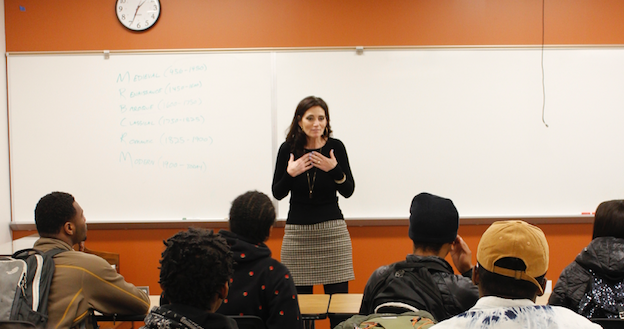How to Foster College Success and Retention among Underserved Students
February 24, 2017
Just minutes before the start of class, Devan, a student at Jackson College, told his professor that he was hungry and had no money or campus meal points to buy food.
Shocked, his English teacher, Amelia Gamel, asked him how he had been getting by. Nervously, he revealed that his strategy consisted of soliciting meal points and food donations from friends – and, that it had been 18 hours since his last meal.
Students like Devan from underserved backgrounds—low-income students, first-generation college students and students of color—often deal with complex challenges that lead to academic disengagement, Gamel says.
Students who live in poverty are in survival mode and can be distracted from academics when their basic needs—food, water, shelter—aren't met, she explains. It sometimes takes "only one negative event for them to walk out of the college door."

Key Strategies for Building Relationships and Engaging Underserved Students

The good news is there are practical strategies that educators can use to engage these students, foster success and improve college retention.
According to Gamel, the key is to build relationships with your students. For instance, after she discovered Devan's situation, she surprised him with a bag of groceries after class one day. "When I did this, he had the feeling that I was on his side."
Her story about Devan is just one of many examples of how she's been there for her students. Connecting with students from underserved populations is a life-long passion and the focus of her work. It is also a personal issue for her; Gamel is a first-generation college student herself who grew up in a single-parent household and struggled with poverty. "I know what they have been through," she says.
In Amelia Gamel's own words, these are the key strategies:
- "Know who your students are, where they're from and what their interests are. Know their history, their values and their beliefs. On the first day of class, I get there early, stand at the door, and welcome everyone personally and shake their hand. I'm interested in who my students are as individuals."
- "Go the extra mile to help them. Treating these students like everyone else is not enough. First-generation students, students dealing with poverty, and students of color often lack the educational, social, and economic capital that their peers have. All of those things can make them feel isolated, alone and insecure. They may need additional tools and help to navigate higher education."
- "Don't take things personally. For example, when students are late to class, some professors take it as a personal thing against them. More often than not, it isn't. For students from low-income neighborhoods, being late can be common. They might be late because they had to take their child to school or they're coming from work. Many have to work while they're in school to pay rent, utilities and other bills."
- "Use compassion and empathy. This goes beyond just faculty members. All campus staff should do this."
Spreading the Message to Educational Professionals
Gamel presented these strategies during a workshop at the 13th Annual DREAM Conference, hosted by Achieving the Dream, a national network of education professionals working to improve postsecondary access and success among community college students. These strategies are the focus of her book, set for release later this year.
The three-day event in San Francisco, which kicked off earlier this week, drew more than 2,000 attendees, including policymakers, thought leaders and practitioners from 200 colleges. At the conference, attendees heard from top leaders on strategies to improve student success through student-centered, data-informed decision-making.
Achieving the Dream is a grantee partner of ECMC Foundation. In 2016, we provided a grant to support and expand the organization's operational capacity.
